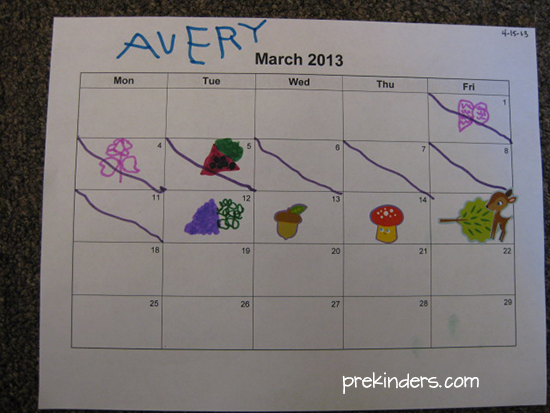Is calendar time really meaningful for Preschool children? How can you make it meaningful for young children? Calendar time is one of those things that started with older children and was pushed down to Pre-K. Any time an older kid concept is brought down to Pre-K, I like to be extra thoughtful in how I go about it.
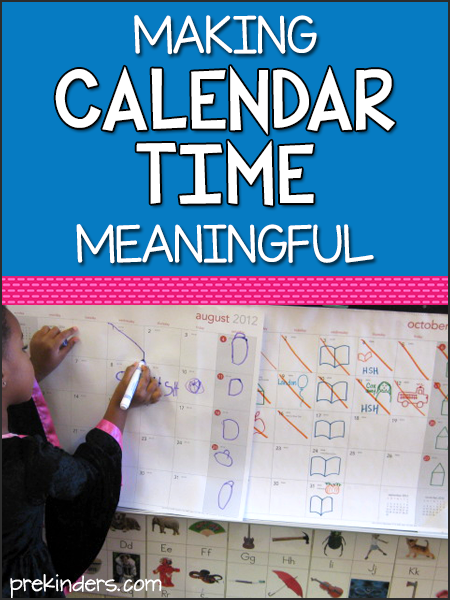
Concepts of Time are Abstract for Preschoolers
Time concepts are very abstract for preschool children. They can’t see time, so it’s very difficult for them to understand. How often have you heard a preschooler use the word “yesterday” to refer to any point in the past? To a young child, yesterday can mean last week, last month, or even last year. To them, yesterday simply means the past. A preschool child might even tell you their birthday is tomorrow when it’s actually two months away. I think we should appreciate the fact that they have come to understand yesterday means the past and tomorrow the future. Then we throw in words like Tuesday and Friday, and those don’t mean past or future. This week Tuesday might mean a field trip and next week Tuesday might mean a puppet show. How does a 4-year-old child, whose understanding that yesterday means “past”, grasp words like Wednesday and March and Saturday and October? You can teach your Pre-K class to recite the days of the week and months of the year, but they don’t really understand what it means.

A real calendar helps preschoolers make connections
I also believe that with Pre-K children, we should keep things as real as possible to help them make connections. That’s why I use a real calendar. I use a desk calendar and I always choose one that’s plain and simple because I draw pictures inside the boxes. Children may notice it’s the same or similar to calendars their parents use at home or in their offices.

Each day, I point out the block on the calendar that represents today, and I draw a diagonal line through it. The reason I do that is because that’s what a lot of adults do on their calendars, and children may notice those similarities between our class calendar and their parents’ calendars. Mainly, it marks the passage of time and shows that these are the days that are over.
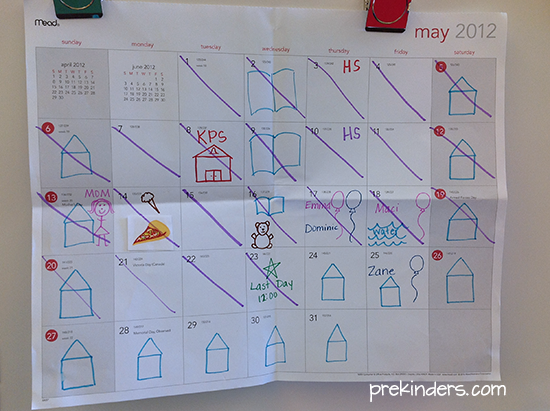
When we have calendar time in my class, I try to make it more like a casual conversation about our days together than a rote memorization routine. I casually say “Today is Tuesday” (or whatever day it is), but we don’t recite the days of the week. I don’t think they’ll grow up lacking this knowledge just because we didn’t do it in Pre-K. I don’t think they’ll fail Kindergarten, either. It hasn’t happened so far. I also don’t say “Yesterday was ___. Tomorrow will be ___.” Preschoolers don’t understand those concepts, as I mentioned above.
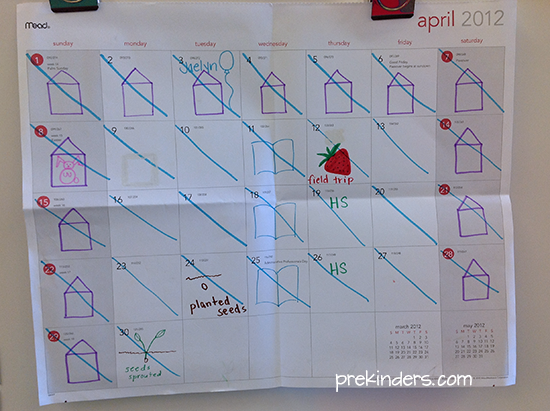
The most important part of our “meaningful calendar” is that I draw simple symbols on our calendar that represent events that are important to our classroom community. If we are going on a field trip to the strawberry patch, I might draw a strawberry. If our butterflies hatched from their cocoon, I would draw a butterfly. I draw a balloon with a child’s name to represent birthdays. I draw a house for “home” days. The book drawn on Wednesdays shows the class when the librarian comes to read to them. I draw symbols for holidays. We do talk about what happened yesterday, or what’s coming up tomorrow by looking at and talking about the picture symbols in the blocks. We might count how many days until a field trip or a birthday or how many days it took for our plants to grow.
Sometimes I add stickers to represent something, but simple drawings are the best. You don’t have to be an artist. In fact, if it looks like a child’s drawing, that’s even better. Why? Because your students will see that making a calendar is something they can do, too!
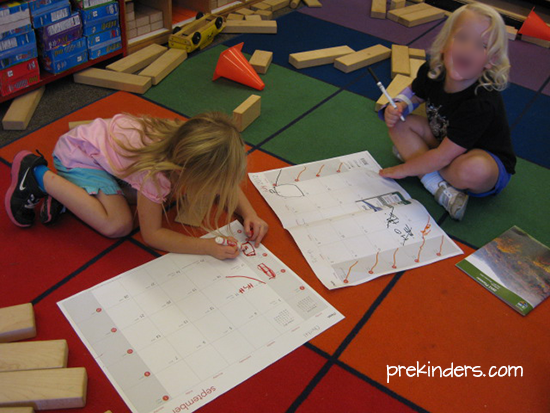
When preschoolers see calendars connected to their lives, they will re-create them in their play
I save any old unused calendar pages and ask for donated calendar pages and the children use these to create their own calendar. They draw symbols on the squares and write letters and sometimes stick stickers on like I do. I print and make copies of small calendar pages and add these to my writing center for children to use.
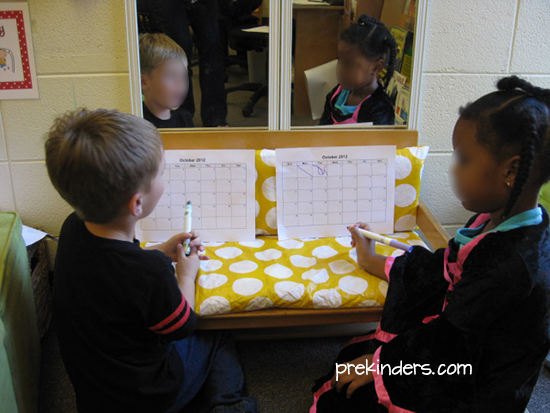
Our calendar can also show science concepts like the growth and change of butterflies or plants. When our caterpillars arrive, I draw a caterpillar on that day’s block. When they form a cocoon, I draw a cocoon. When they hatch, I draw a butterfly.
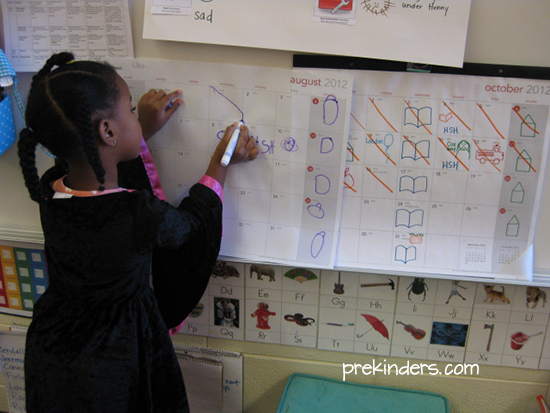
I once considered using a dry erase calendar, but decided to stick with the desk calendar because we have permanent record of our year together. I save all of our old months after I tear them off the desk calendar and we do refer back to them to remember all the things we’ve done through the year. I also add free or dollar store wall calendars and planners to our writing and house centers.
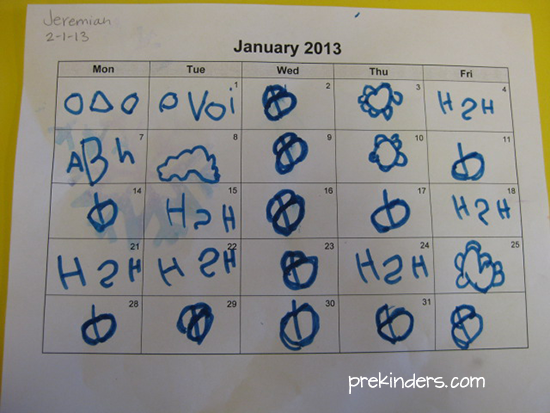
Is a Linear Calendar better?
I’ve noticed that linear calendars have become popular in preschool in recent years. On a linear calendar, teachers have the days stretched out across one wall with all 30 or so days in a line. Some teachers prefer this. I personally still prefer a desk calendar that I can draw symbols on for a couple of reasons.
- A “regular” calendar looks like a real life calendar. The closer we make connections to real life, the more meaningful it is to children.
- A “regular” calendar will demonstrate left to right, top to bottom progression, which is important for pre-readers. Would you expect them to understand that concept yet? No, but you’re demonstrating it every week, without even saying a word.
More Information on Calendar Time
I wrote this in response to questions I’ve received about how I do calendar time in my classroom. I’m fully aware that not everyone will agree with me, and that’s fine. I believe this is meaningful and developmentally appropriate for 4-year-olds. I also highly recommend this NAECY article by Lilian Katz: Calendar Time for Young Children (PDF).
If you do feel you need to teach children to recite days of the week and months of the year, I recommend teaching it through song. Dr. Jean and Jack Hartmann have some nice songs that teach weeks and months. My students leave my class familiar with the names of the days and months, but might not be able to recite them in order.
